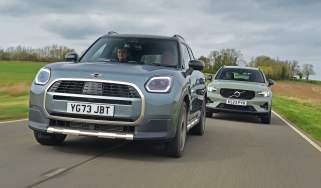Mitsubishi Evo
If you're looking for supercar performance with everyday practicality, then look no further than the mad Mitsubishi Evo.
Supercars used to be mid-engined, very expensive and totally impractical – then the Mitsubishi Evo arrived. It didn’t just move the goalposts - it dispensed with them completely. Here was a car could out-brake and accelerate models costing twice as much and carrying a family of four and their luggage at the same time.
Devastatingly fast, amazingly reliable but costly to run, the Evo is one of those cars that every enthusiast should experience at least once in their life. However, they’re seriously complicated and their sky-high running costs lead some owners to cut corners, which makes finding a good one of paramount importance. Here, we show you how.
History
The first Lancer Evo was built in 1992, but it wasn’t until the Evo VI arrived in 1999 that the car was officially sold in the UK.
The Evo VII followed in autumn 2001. It was based on the Japan-only Cedia, rather than the Lancer, and packed 276bhp. Then at the start of 2002 there was an even more powerful FQ-300 edition on offer.
The Evo VIII arrived in March 2003, with 276bhp as standard but with the option of upgrading to FQ-300 specification. In October of the same year it was joined by an FQ-330 option.
Things got even more complicated in April 2004 when a new entry-level Evo VIII, with 260bhp, plus various MR (Mitsubishi Racing) derivatives arrived. The latter (including 280, FQ-300, FQ-330 variants) feature forged alloy wheels, an aluminium roof and revised suspension.
Within weeks there were also FQ-320 and FQ-340 derivatives and by the end of the year the completely insane FQ-400 had arrived – but just 100 were offered at £47,000 apiece.
The last of the line Evo IX hit showrooms in June 2005, in FQ-300, FQ-320 and FQ-340 guises. By September 2006 there was also an FQ-360 option.
The final edition was the MR FQ-360 of January 2007, with small cosmetic and interior tweaks plus minor engine upgrades.
What to look for
Grey imports are common but, if you’re considering one, make sure there’s plenty of history available. Also, make sure you get a title and mileage check from the British Independent Motor Trade Association (www.bimta.co.uk).
Ask what type of security system is fitted too, because most insurance companies insist on a Tracker before they’ll offer cover. If one of these isn’t installed, you’ll need to budget at least £500 to fit a decent one – but insurance will still be expensive because all these cars are all group 20.
If the car has been used for track days make sure you pay extra special attention to the tyres and brakes, because they take a hammering during circuit use.
Running costs
Servicing an Evo isn’t cheap because attention is needed every 4,500 miles or six months (except the 260 editions, which go for twice as long between services).
While many of the services are little more than an oil change (typical cost is £95) every other visit will soak up closer to £200-250, assuming nothing else needs doing.
The 54,000-mile service is the big one, as this involves replacing the cam belt. Expect a bill for around £600. These prices include any brake fluid or coolant renewals when necessary, although it’s recommended that the air-con is recharged every two years, at an extra £85.
Alternatives
The key rival is Subaru’s Impreza, which compares favourably in terms of price, running costs, dynamic abilities and practicality.
While the Mitsubishi is the more focused and faster, the Subaru is easier to live with day-to-day and cheaper to buy. Both cars have cheap interiors and high running costs, though.
In terms of performance, the Evo can match the thrills of just about any supercar, but if you want a premium interior and prestige badge too, then you’ll have to consider an Audi RS4 or Mercedes C55 AMG. These two are much more costly and less fun to drive.
Useful links
www.evolutionm.net
www.lancer-evo.net
www.lancerregister.com
www.mitsubishiforum.com
www.mitsubishi-cars.co.uk
Verdict
It doesn’t matter which generation Evo you buy, or what power output the engine offers, because you’ll have a blast every time you take it out.
The Evo enjoys typical Japanese engineering, which means reliability comes as standard, but there are plenty of cars that haven’t had the correct maintenance. There are also too many examples that have been crashed or badly modified.
You really need to have your wits about you before buying any Evo, but track down a good one and you’ll never look back.
Extra Info
Buyer beware!
- Whining from the gearbox means the output shaft bearing has worn - and repairs can cost more that £1,000.
- The Evo is a thief magnet, so make sure it has a Thatcham category 1 security system - your insurance company will insist on one.
- If an aftermarket exhaust system has been fitted, then check that the catalytic convertor hasn't been removed.




